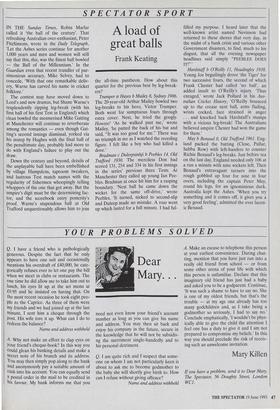SPECTATOR SPORT
A load of great balls
Frank Keating
IN THE Sunday Times, Robin Marlar called it 'the ball of the century'. That refreshing Australian over-enthusiast, Peter FitzSimons, wrote in the Daily Telegraph, `Let the Ashes series continue for another 1,000 years and men and women will still say that this, this, was the finest ball bowled — the Ball of the Millennium.' In the Guardian even that recent trundler of par- simonious accuracy, Mike Selvey, had to concede, 'With that one remarkable deliv- ery, Warne has carved his name in cricket folklore.'
The contest may have moved down to Lord's and new dramas, but Shane Warne's resplendently ripping leg-break (with his first ball of his first Test in England) which clean bowled the mesmerised Mike Gatting at Manchester will continue to reverberate among the romantics — even though Gat- ting's second innings dismissal, yorked via his instep by Hughes with the final ball of the penultimate day, probably had more to do with England's failure to play out the draw.
Down the century and beyond, details of the unplayable ball have been embellished by village Hampdens, taproom tweakers, and lustrous Test match names with the regularity of fishermen whoopingly telling whoppers of the one that got away. But the umpire's digit must be the determining fac- tor, and the scorebook entry posterity's proof. Warne's stupendous ball at Old Trafford unquestionably allows him to join the all-time pantheon. How about this quartet for the previous best by leg-break- ers?
Trumper st Hayes b Malley 8, Sydney 1906. The 20-year-old Arthur Mailey bowled two leg-breaks to his hero, Victor Trumper. Both went for sumptuous fours through extra cover. Next, he tried the googly. Howzee! 'As he walked past me,' wrote Malley, 'he patted the back of his bat and said, "It was too good for me." There was no triumph in me as I watched the receding figure. I felt like a boy who had killed a dove.'
Bradman c Duleepsinhji b Peebles 14, Old Trafford 1930. The merciless Don had scored 131, 254 and 334 in his first innings in the series' previous three Tests. At Manchester they called up young Ian Pee- bles. Bradman at once hit him for a rasping boundary. 'Next ball he came down the wicket for the same off-drive,' wrote Peebles. 'It turned, nicked to second-slip and Duleep made no mistake. A roar went up which lasted for a full minute. I had ful- filled my purpose. I heard later that the well-known artist named Nevinson had returned to these shores that very day, in the midst of a bank crisis and various other Government disasters, to find, much to his disgust, that all the evening newspaper headlines said simply "PEEBLES DOES IT!"' Hardstaff b O'Reilly 11, Headingley 1938. Young Joe beguilingly drove 'the Tiger' for two successive fours, the second of which Frank Chester had called `no ball', an added insult to O'Reilly's injury. 'Thus enraged,' wrote Jack Pollard in his Aus- tralian Cricket History, 'O'Reilly bounced up to the crease next ball, arms flailing, wrists cocked, face strained in anger . . . and knocked back Hardstaffs stumps with a vicious leg-break! The Australians believed umpire Chester had won the game for them.'
May b Benaud 0, Old Trafford 1961. Eng- land packed the batting (Close, Pullar, Subba Row) with left-handers to counter Richie Benaud's leg-breaks. Just before tea on the last day, England needed only 106 at a run a minute with nine wickets left. Then Benaud's extravagant turners into the rough gobbled up four for nine in four overs, including the captain Peter May, round his legs, for an ignominious duck. Australia kept the Ashes. 'When you try something and it comes off, it gives you a very good feeling', admitted the ever lacon- ic Benaud.


















































 Previous page
Previous page